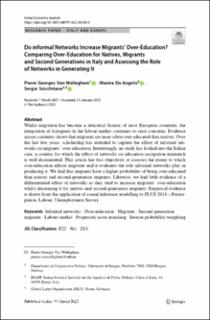| dc.contributor.author | VanWolleghem, Pierre-Georges | |
| dc.contributor.author | De Angelis, Marina | |
| dc.contributor.author | Scicchitano, Sergio | |
| dc.date.accessioned | 2022-06-10T08:20:50Z | |
| dc.date.available | 2022-06-10T08:20:50Z | |
| dc.date.created | 2022-03-04T10:33:50Z | |
| dc.date.issued | 2022 | |
| dc.identifier.issn | 2199-322X | |
| dc.identifier.uri | https://hdl.handle.net/11250/2998264 | |
| dc.description.abstract | Whilst migration has become a structural feature of most European countries, the integration of foreigners in the labour market continues to raise concerns. Evidence across countries shows that migrants are more often over-educated than natives. Over the last few years, scholarship has intended to capture the effect of informal networks on migrants’ over-education. Interestingly, no study has looked into the Italian case, a country for which the effect of networks on education-occupation mismatch is well documented. This article has two objectives: it assesses the extent to which over-education affects migrants and it evaluates the role informal networks play in producing it. We find that migrants have a higher probability of being over-educated than natives and second-generation migrants. Likewise, we find little evidence of a differentiated effect of networks as they tend to increase migrants’ over-education whilst decreasing it for natives and second-generation migrants. Empirical evidence is drawn from the application of causal inference modelling to PLUS 2018—Participation, Labour, Unemployment Survey. | en_US |
| dc.language.iso | eng | en_US |
| dc.publisher | Springer | en_US |
| dc.rights | Navngivelse 4.0 Internasjonal | * |
| dc.rights.uri | http://creativecommons.org/licenses/by/4.0/deed.no | * |
| dc.title | Do informal Networks Increase Migrants’ Over-Education? Comparing Over-Education for Natives, Migrants and Second Generations in Italy and Assessing the Role of Networks in Generating It | en_US |
| dc.type | Journal article | en_US |
| dc.type | Peer reviewed | en_US |
| dc.description.version | publishedVersion | en_US |
| dc.rights.holder | Copyright 2022 The Author(s) | en_US |
| cristin.ispublished | true | |
| cristin.fulltext | original | |
| cristin.qualitycode | 1 | |
| dc.identifier.doi | 10.1007/s40797-022-00184-5 | |
| dc.identifier.cristin | 2007551 | |
| dc.source.journal | Italian Economic Journal | en_US |
| dc.identifier.citation | Italian Economic Journal. 2022. | en_US |

